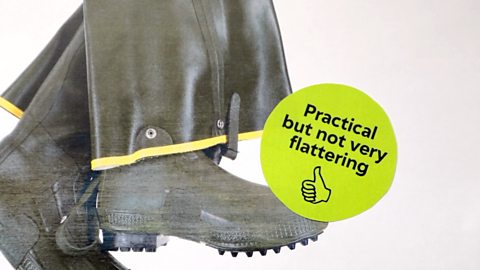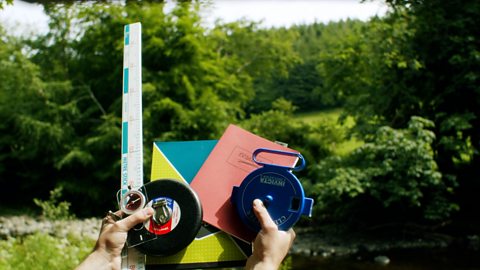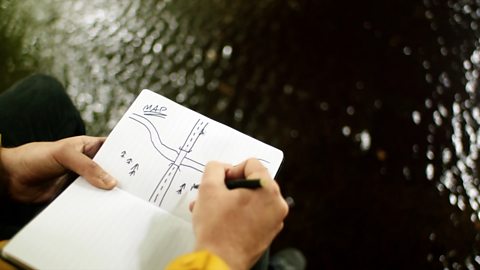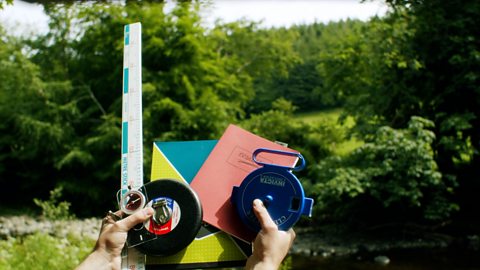Fieldwork example
Fieldwork allows us to analyse our surroundings in real detail by measuring, collecting information, talking to people and using maps and equipment. It’s the best way to learn!
Before you start any piece of fieldwork – you need to work out what it is that you are wanting to test or examine along the river. Fieldwork needs to start with a good hypothesis. A hypothesis is a statement that can be either proved or disproved by what you measure in the fieldwork. If you don’t know what you are testing or looking for, your fieldwork won’t have a focus.
Without the right hypothesis or enquiry questions, you won’t develop the right method to get the right data. Your hypothesis should be applicable to the place you wish to conduct your fieldwork. Once you have a precise hypothesis, your methods should be developed according to these two questions:
- What data are you going to collect?
- How are you going to collect it?
Fieldwork can be carried out on a variety of topics, for example:
- Coasts: Measuring size of stones/pebbles on a beach; measuring pollution; analysing coastal erosion and deposition
- Weather: recording the different elements of the weather.
- Litter: Looking at the amounts of litter/ rubbish left in different places; comparing differences between sustainable and non-sustainable waste management.
- Settlement: Comparing the land use of one place compared to another; looking at the differences between a rural and urban settlement; looking at the services/land use in different parts of a city.
- Population: studying the number of people who live in an area or who come to a particular place; analysing migrant patterns within a country or area,
- Tourism: counting the numbers of tourists from different places and analysing the places where they have come from.
- Renewables: looking into the different opinions that people have about wind farms or solar farms.
Good planning and safety

One of the most important parts of any fieldwork is planning your trip properly and making sure there's as little chance as possible of any injuries occurring. Of course, the whole point of fieldwork is to explore, inspire, be curious and learn, but you need to ensure nobody gets into any danger. Follow this safety checklist:
- Before leaving for the site of your fieldwork, you must think about the risks that you might come across.
- Usually, when conducting fieldwork, you do so in a group, so discuss the project with the group carefully and agree on everyone’s role.
- If you are going to a river, you and your group will need to ensure that the group comes properly clothed (wear wellies and bring dry socks and shoes to change into).
- Good communication is essential for a successful fieldtrip.
- Work together when assessing the risks when doing your fieldwork.
- At a river, it is important to check the depth of any water before venturing into it.
- Avoid steep banks, turbulent water and muddy places where you can’t see the bottom. If you have any doubt, you’re best to stay out and find an alternative spot to conduct your fieldwork.
In short, identify as many risks as you can, the likelihood of them happening, their severity and what you can do to prevent them.

Data Collection
The best bit of any fieldwork is getting to collect the primary source information.
Once you have worked out what your hypothesis is - you can start to plan the information that you need to collect. For example, in a river you might need to collect the width and depth of the river at six places/sites along the length of the river. This would mean that you would have to identify six different accessible places where you collect this information. You could use an Ordnance Survey map to help you find good sites. The next step is to make a results sheet that can be used to collect your results from each site. Then it’s all about making sure you have the right equipment and arranging the day to go and collect the information.

Presentation, analysis, conclusion

When you have completed your fieldwork, the next stage is to evaluate your data and either prove or disprove the original hypothesis by doing the following:
Presentation: Depending on what type of fieldwork you carry out, you might need to sketch a map, create graphs from your data collection, or take and show photos from your work as part of your presentation. For example, you might be able to draw a bar chart that compares the different widths of the river at the different sites that you have visited.
Analysis: Once you have found the best way to present your data, you will need to analyse it. This means you will have to relate your collected data back to your enquiry question or hypothesis. Describe what your graph shows. Are there any trends or patterns from what you can see? Are there any unusual results?
Interpretation: What does your data say in relation to your hypothesis? Explain the results you found. Are there any reasons why this is the case? Is there anything else that you have learnt in geography that can help explain why you found what you did? Did you prove or disprove your hypothesis? For example, you might note that in your bar chart of the widths of the river, that the river gets much wider towards the mouth. This is because the further downstream that you go – the river is joined by other streams and tributaries that add to the amount of water in the river so the river must increase in size to cope.
Finally, you will need to sum up what you have found in the fieldwork by writing up a short conclusion.
Conclusion: This is where you refer back to your hypothesis and state whether you agree or disagree and briefly note the reasons why you are saying this. You might also note anything which surprised you or even things that might have changed the results from what you might have expected. For example, if you were carrying out fieldwork at Glenarm river, perhaps your data would be more accurate if you came back on other days when the weather conditions were different from the day of your fieldwork - eg with heavier rainfall, because the volume of water would increase the depth of the river.
Evaluation: Sometimes you might even be asked to include a short evaluation where you will reflect in the work you have carried out and try to improve how you collected the data/information.
More on Field Work
Find out more by working through a topic
- count3 of 3

- count1 of 3
